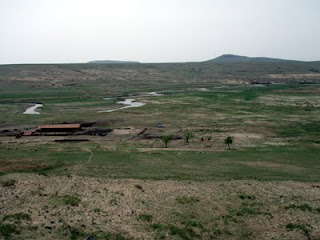0730. We left "Jinbihuihuang" hotel, had a quick breakfast (I must remember not to eat the cold preserved vegetables). We got ~10 L of #97 gasoline for the generator, and drove on west towards Abaga Qi (~90 km). We stopped at a brick factory on the way, where we found a few bone fragments (Hongjiang said rhino teeth were found here years ago).
After our arrival in Abaga, we saw that the Abaga Hotel is under renovation. We were led to a smaller motel by Hongjiang's colleage Wu Baoliang (director of the local cultural survey). We then headed to the general store (on the same street as the old Abaga Hotel) to buy shovel handles, pick-ax, nylon bags for matrix, water jugs, face masks, and asked around for plaster (we won't buy any burlap and plaster until the excavation in June).
1430. We drove to IM0704 to check out the current state of the exposures, and there are three or four possibilities for the full scale excavation. We visited IM0703 shortly after. Now I have a better idea about what to accomplish in June.
 [The site of an ancient stone-covered grave which was probably sacked during the past decade by a one of the many groups of grave-robbers]
[The site of an ancient stone-covered grave which was probably sacked during the past decade by a one of the many groups of grave-robbers]-IM0703 is very restricted in area, and the sediment is soft. Unless there is nothing further at IM0704, we should not spend too much time (if any) there.
-the north side of IM0704 is clear (not covered by large basalt chunks) but steep; the fossilifoerous layer is thin, and a lot of grey overburden is present. The southeast side where I dug into two femoral heads is geologically complex, with potential sliding of edge sediment downward. The fossils there are large in size but appear scattered on the suface. The other possibilities are near where the Hipparion was extracted in 2007; the degree of fossil concentration there is satisfactory. I would like to concentrate on that part for the excavation. The surface overburden is soft, but the layers immediately above the fossiliferous stratum are hard, and will probably require the jackhammer which needs to be carried up the wash (it's too difficult from the top because the basalt chunks are very slippery).
~Jack





